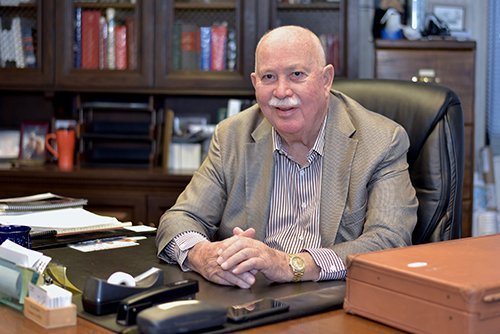
Gary Whitener knew his heart was in trouble a few years ago when he would get winded climbing a flight of stairs.
Subbarao Myla, M.D., F.A.C.C., cardiologist and director of Hoag Cardiac Cath Labs, said Gary’s heart valve was damaged, and recommended he be evaluated for a transcatheter aortic valve replacement. Gary underwent the hour-long procedure at the Jeffrey M. Carlton Heart & Vascular Institute at Hoag.
“I didn’t feel any pain at all when I woke up; I noticed the difference almost immediately,” said Gary, 79, a month after the procedure. “I have no trouble getting up and down the stairs. Even if I get winded, I recover more quickly.”
Gary’s experience is an example of Hoag’s dedication to providing the most effective, evidence-based technology and procedures.
Hoag was the first in Orange County to offer transcatheter aortic valve replacement (TAVR), and is an industry leader in traditional surgical aortic valve replacement (SAVR).
SAVR remains the gold standard in care for individuals at low risk for complications during surgery, and continues to be a highly utilized, effective option for patients.
TAVR is a minimally invasive approach to replacing a damaged heart valve. During a TAVR procedure, Hoag’s multidisciplinary team delivers a collapsible artificial valve into the heart through a catheter. Utilizing advanced imaging technology, this thin-flexible tube is inserted into the body through the groin. The artificial heart valve is then inserted across the patient’s own aortic valve, where it almost immediately goes to work.
TAVR originally was indicated for patients at high risk for complications during a SAVR – determined high risk due to other pre-existing conditions besides their heart disease that could place them at an increased risk during surgery. Until TAVR, these high risk patients had no other option for replacing their heart valve.
Recently, TAVR has also become available for patients at intermediate risk of complications during surgery, and through a new clinical trial at Hoag, it is being evaluated in patients who are at low risk of complication during traditional surgery (SAVR).
At Hoag, the cardiac team works with each patient to determine the most appropriate approach to care. Not all patients will qualify for TAVR, and might be excellent candidates for SAVR.
“The advantage is that TAVR eliminates obstruction in the aortic valve, similar to a surgical aortic valve replacement, but without a chest incision,” said Aidan A. Raney, M.D., program director of Hoag Cardiovascular Surgical Services and the James & Pamela Muzzy Endowed Chair in Cardiovascular Surgery. “Both procedures eliminate shortness of breath and other symptoms associated with aortic stenosis.”
The TAVR procedure at Hoag is overseen by a team of specialists including cardiac surgeons, cardiologists, interventionalists, cardiac anesthesiologists, echo cardiologists and a nurse coordinator, and performed in the state-of-the-art Bob & Marjie Bennett Advanced Cardiovascular Surgery Suite (Hybrid CVOR), the first operating room of its kind in Orange County.
“The procedure takes under an hour, and the patient goes home the next day. It’s a dramatic change from surgical aortic valve replacement,” said Dr. Myla. “What we found is the less invasive, the faster the recovery. What we are waiting to see, is if the long term outcomes for TAVR are as excellent as SAVR.”
Since 2011, Hoag cardiac specialists have performed the TAVR procedure almost 300 times and might conduct as many as 100 this year alone, making them the most experienced team in all of Orange County. The technology has continued to improve since 2011, offering more valve sizes and smaller delivery devices.
Gary, who in 1971 founded his Orange County company that manufactures vinyl and rubber seals, appreciates modern technology like TAVR that has a similar innovative approach as the business he started.
“I didn’t want open-heart surgery. I am thankful for the development of this technology,” Gary said while he sat in his office chair. “I’m living in a wonderful age.”








